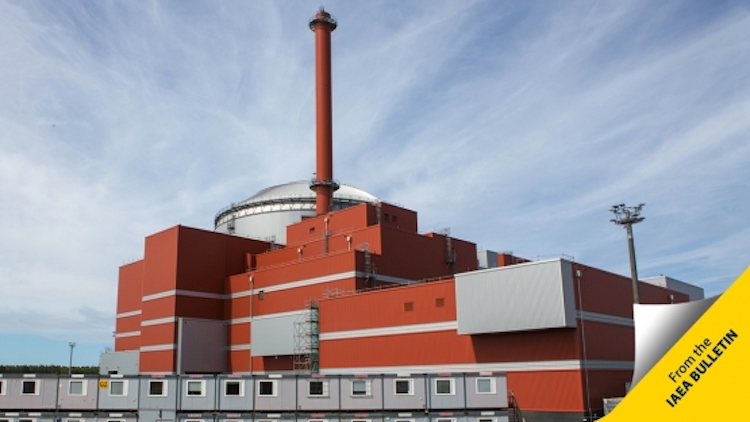By Jeffrey Donovan
The author is Press and Public Information Officer of the International Atomic Energy Agency (IAEA), based in Vienna. This article first appeared on the IAEA website on November 16, 2018.
VIENNA (IDN-INPS) – Along the pine-lined shores of Finland’s bucolic western coast, a clean energy vision of the Nordic country’s future is quietly taking shape. On the tiny island of Olkiluoto, workers are applying the finishing touches to a new Evolutionary Pressurised Reactor (EPR) set to supply 10% of Finland’s electricity needs. Like all nuclear power reactors, the massive 1600 MW unit will emit virtually no greenhouse gases (GHG) even as it churns out a steady stream of baseload electricity capable of providing power to millions of homes.
“Welcome to the future,” said Pasi Tuohimaa, an executive with Teollisuuden Voima Oyj, the private Finnish company that owns and operates two older reactors at Olkiluoto as well as the new EPR reactor. Standing in the reactor hall of the new unit, due to begin operation in late 2018, Tuohimaa waxed philosophical: “Every morning, when I’m there watching myself in the mirror, I’m really thinking, ‘I’m going to save the world — with nuclear.’”
The country of 5.5 million people has long relied on the atom to supply power and heating to households and energy-intensive industries — especially during the long, dark winters. Now, under a national energy and climate strategy that outlines Finland’s contribution to the 2015 Paris Agreement to combat global warming, the Government envisions a mix of renewable sources and nuclear energy as the key to achieving its loftiest goal: becoming a carbon-neutral society by mid-century.
“One cannot make a difference between climate policy and energy policy nowadays, and the main aim of Finnish energy policy is to lower greenhouse gas emissions,” said Riku Huttunen, Director General of the Energy Department at the Ministry of Economic Affairs and Employment. “The most important instrument for that is renewable energy sources, but of course we should use all the possibilities to cut emissions and nuclear energy provides one good solution for that.”
Finland’s embrace of nuclear power dates back to the late 1970s, when the first of its four existing nuclear power reactors — which provide one-third of Finnish electricity production — began operation. Besides a lack of indigenous fossil fuels, Huttunen said the most important reason for introducing nuclear power was to ensure plentiful energy for the country’s long winters, as well as its forestry, steel and chemical industries.
From energy security to greenhouse gas reduction
But as the goal of energy policy shifted in recent years to GHG reduction, other advantages of nuclear power came into focus. While the Government aims to phase out coal and increase the use of renewables, such as solar, wind and biofuels, to cut emissions by up to 95% by 2030, policymakers also say that achieving both energy security and climate goals will not happen through intermittent sources alone.
“Smart grids will help, but we would need a huge energy storage in order to manage with solar power and wind power only — and there are no such technologies yet,” Huttunen said.
When the new reactors become operational at Olkiluoto and Hanhikivi, another plant planned for construction in the coming years, nuclear power may provide more than half of Finland’s electricity production — all virtually free of GHG emissions. In addition, Finland is on track to become the first country to operate a deep geological repository for the permanent disposal of nuclear spent fuel. It is expected to begin operation in the mid-2020s.
“The fact that nuclear energy production is carbon free is quite well accepted and understood in Finland in society, and this is of course promoting these new build projects,” said Liisa Heikinheimo, who is responsible for nuclear energy as Deputy Director General of the Energy Department at the Ministry of Economic Affairs and Employment. “Additionally, efforts in Finland to manage the disposal of spent nuclear fuel have also been important for the public acceptance of nuclear power.”
Finland’s energy and climate strategy also looks into the possibility of eventually relying on renewables for all the country’s energy needs. But for now, Huttunen says that’s not realistic — and not only for Finland.
“If we want to meet the Paris climate agreement goals — and at the moment we are far, far from the path — we have to take advantage of all low-carbon technologies,” he said. “Whether individual countries want to do that is a political decision, but as a globe we also need nuclear power to reach the climate goals.” [IDN-InDepthNews – 17 November 2018]
Photo: The new Evolutionary Pressurised Reactor, built by a Franco-German consortium, on Olkiluoto Island in southwestern Finland. It is expected to provide 10 per cent of Finland’s electricity when it becomes operational, probably in late 2018. Credit: S. Slavchev/IAEA
IDN is flagship agency of the International Press Syndicate.
facebook.com/IDN.GoingDeeper – twitter.com/InDepthNews

